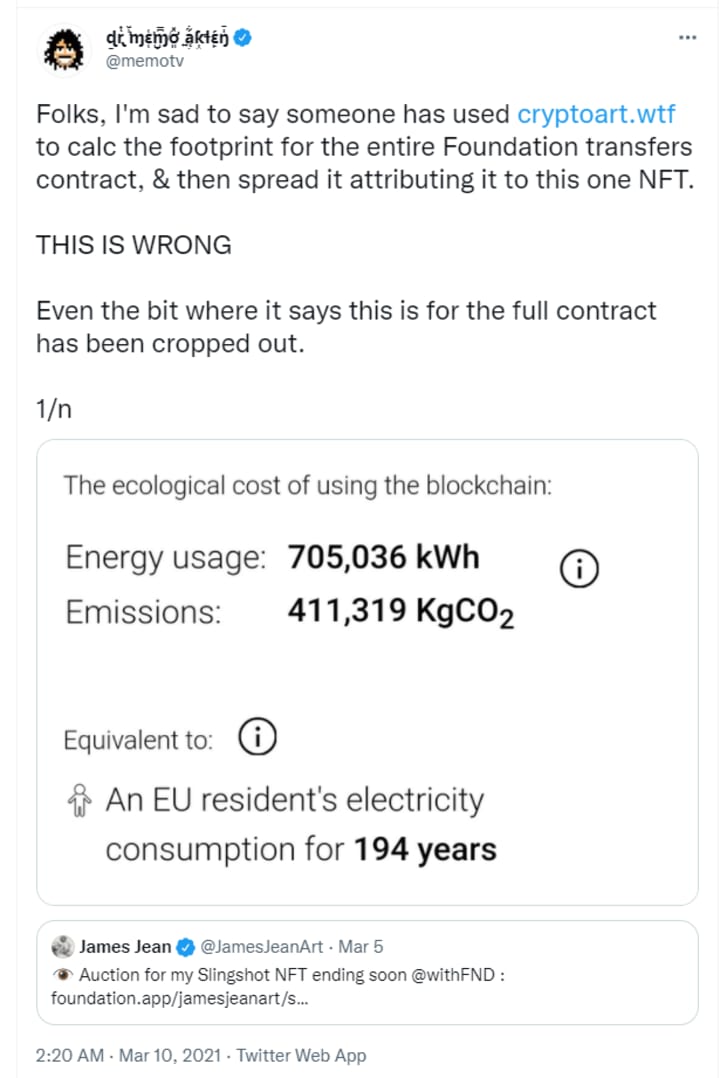NFTs, Environmental Impact and Checking your Sources
One source to ruin it all

It is often brought up how NFTs are bad for the environment. How is that possible? It's like saying using my computer to read articles online is bad for the environment, right? Unfortunately, as with all things, it is more complex. While both the contents of an article and the existence of an NFT are both inherently inert bytes of data, much of the functionality of the NFT is in the smart contracts that are attached to it. According to IBM, “Smart contracts are simply programs stored on a blockchain that run when predetermined conditions are met.” In the case of NFTs, the smart contracts are attached to the tokens and when NFTs are bought, sold or have actions performed on them in something like a blockchain game, the smart contracts trigger, much like one would set up automation steps in IFTTT.
Some of the most basic, common smart contracts used for NFTs include attaching data from the NFT to files in a repository such as IPFS and restricting access to external assets to NFT owners only. On the NFT trading platform OpenSea, the most common smart contract is one of its biggest draws; tracing a percentage of the royalties back to the original creator with each sale. The more complex the contract, the more blocks in the Ethereum blockchain will be required to process the request. Not only does this put more strain on the system to process, the increased number of processes all means that there will be an increased gas fee.
While increased processing power is not directly related to power draw, it does mean increased runtime of the machines. Earlier this year (2021), there had been some scary statistics being circulated about the impact of 1 NFT transaction equating to months or even year’s worth of usage of energy. Authors of most of these articles were using a site called CryptoArt.wtf to calculate the environmental impact of transactions. Not long after the site received a lot of attention, it was shut down and when accessed today (November 5, 2021) bears this message:
“CryptoArt.wtf was designed to share the best available information about the energy use and environmental impact of the growing Proof-of-Work (PoW) based CryptoArt and NFT markets. Just as we can find information regarding the ecological costs of flying, iPhones, watching Netflix, or training Artificial Intelligence models, I believe similar information should be available for CryptoArt, so that we can understand the impact of our actions, and we can make informed decisions. Unfortunately, the information on this website has been used as a tool for abuse and harassment, so I am taking the site offline.
I support artists, and we should support each other. Even as we navigate our messy interactions with extractive capitalism. Our conversations should not be around comparing individuals to each other, comparing you to them, or me to you. Instead, I believe we have a responsibility to be critical of businesses whose values are opposed to the values that we wish to see moving forward, while simultaneously we work towards building and supporting equitable platforms that avoid senseless damage to our planet. CryptoArt is a tiny part of global emissions. Our actions in this space is a reflection of the mindset that we need in our efforts for larger-scale systemic change.
Since the release of this website in December 2020, there have been a plethora of articles reflecting on the CryptoArt market. For a very brief list of resources, please see:
Toward a New Ecology of Crypto Art: A Hybrid Manifesto: A collection of short essays presenting a number of different perspectives
A guide to more sustainable CryptoArt
Cumulative footprints for Ethereum based PoW CryptoArt marketplaces
Bitcoin and other PoW coins are an ESG nightmare for a comprehensive survey of the PoW industry
Carbon.fyi to calculate emissions for a single Ethereum wallet or contract”

While this message seems to indicate that the artist was acting in good faith to provide transparent data about the dangers of NFT usage, the website developer, Memo Akten, has since made it clear that the data is somewhat “one-sided” as he feels the ecological impacts have not been a big enough part of the conversation. When he divulges this information in one of his Medium articles, he does also provide resources to reasonable “pro-Bitcoin,” meaning a proof of work system and a “reasonable anti (POW) position.”
The fault is not entirely his own, as his calculator was misused and the usage of an NFT platform, The Foundation, was said to be the usage of ONE NFT transaction. This astronomical statistic was posted, picked up as fact and has caused a lot of reputational damage. Akten tries to stem the misinformation with his tweet, but fixing something like this is near impossible.

So where does this leave us?
If we are to trust this individual’s recommendations, we would use the Carbon site to calculate the carbon emissions. This site will calculate either a wallet’s worth of transactions or a contract address’ transactions. There is an option to choose to analyze outgoing only (the default) or to check a box to include both incoming and outgoing transactions. But, do we trust this information?
I am skeptical, but not outright unbelieving. I am fairly certain that this site is another inception of the author’s original website, due to noting that most of the references he listed are links to some of his other articles as well as his own GitHub repository. However, Carbon.FYI does provide their methodology and the many factors that they do consider. It is quite refreshing.
Some of the factors they consider include:
- the formula used
- geographic attribution to types of power generation
- their assumptions
- known limitations
While I greatly appreciate the clarity, and especially the attribution to types of power generated in certain areas, it does not, however, do anything to alleviate the damage already done that sits in people's minds about the "extreme environmental dangers of NFTS!" that was based on purposefully skewed data. While the environmental impact does factor into adoptions of NFTs programs, it is most likely not nearly as dire as many people think, all due to the incorrect data from this individual.
In the NFT space, it can be often found on Twitter, the acronym, DYOR. This stands for “Do Your Own Research.” Research is not only finding the articles, but also tracing sources, reputation and motivations.
Don’t get rugged due to misleading information.

About the Creator
Rachel Pieper Decker
Displaced Minnesotan in Southern California.
Gamer, streamer, fiber arts enthusiast, Web3 dabbler, aspiring Notary Public
Connect with me: twitter.com/HyperZenGirl * twitch.tv/HyperZenGirl
Affiliate links: https://linktr.ee/HyperZen






Comments
There are no comments for this story
Be the first to respond and start the conversation.